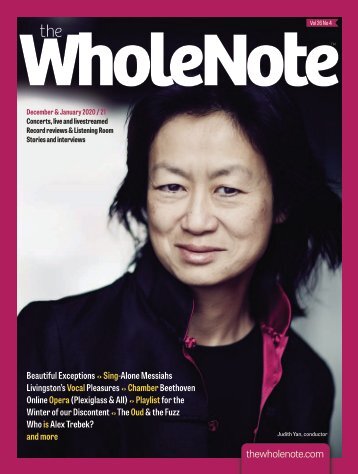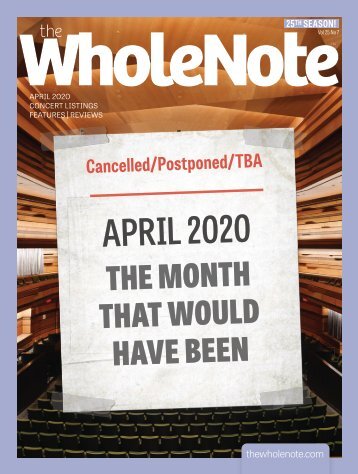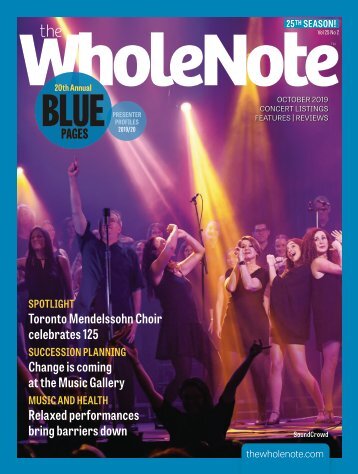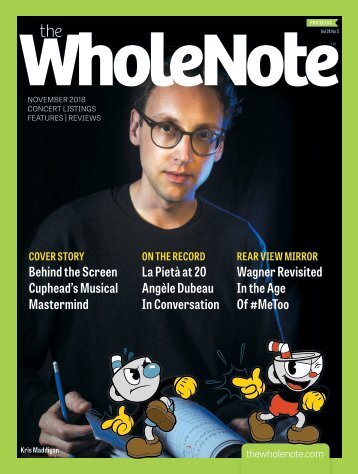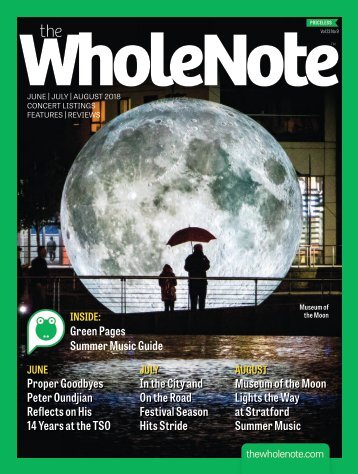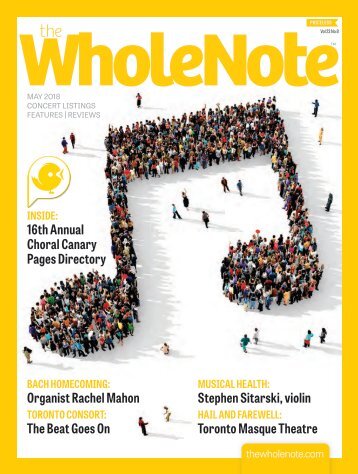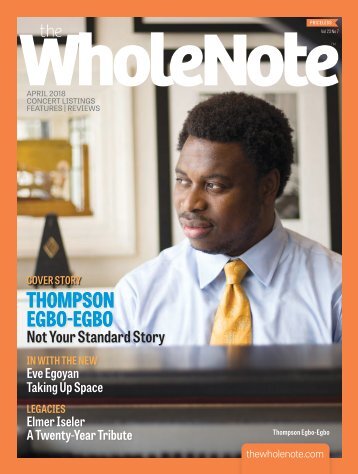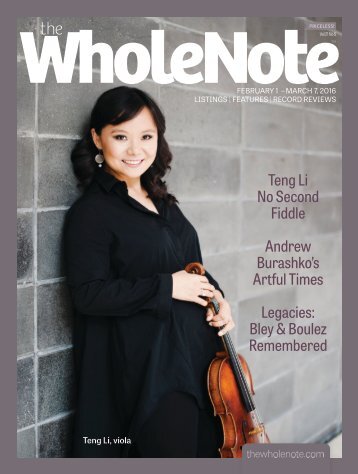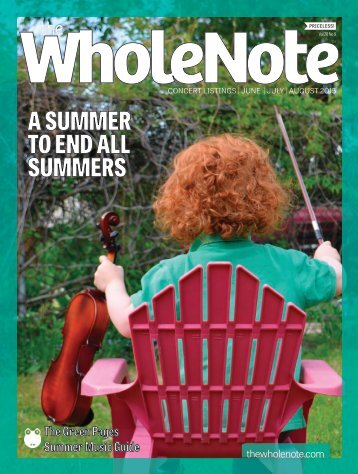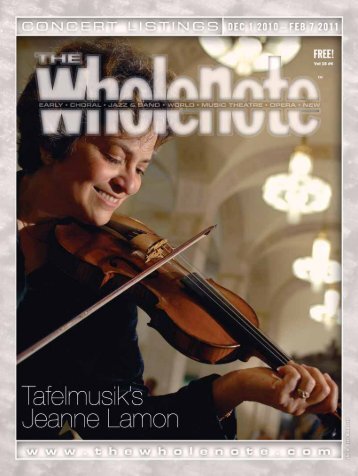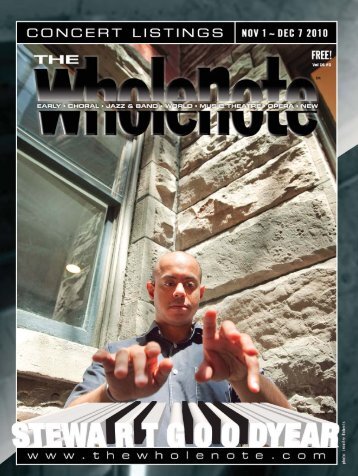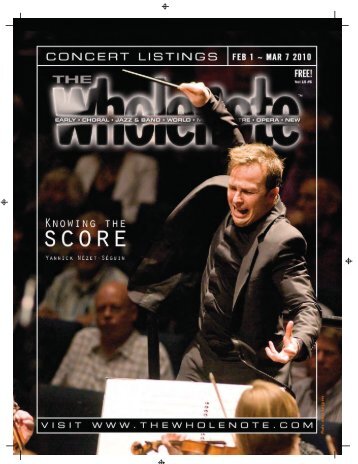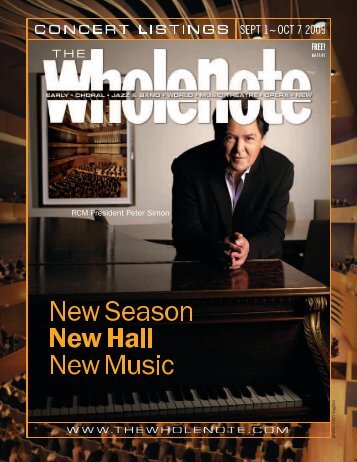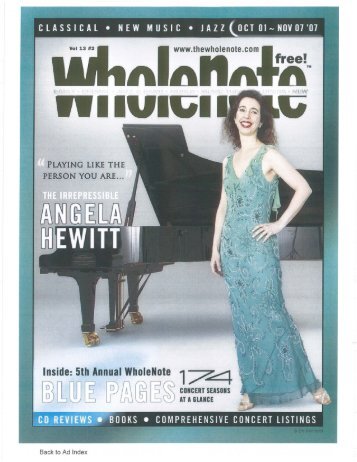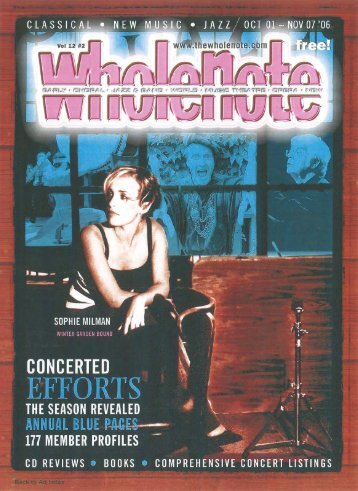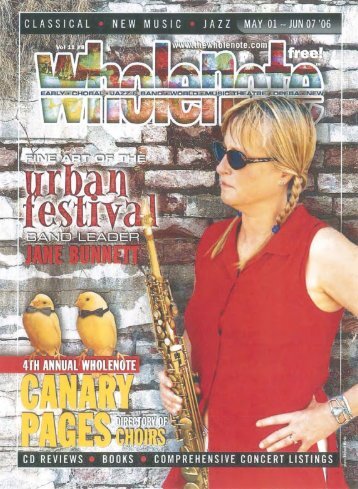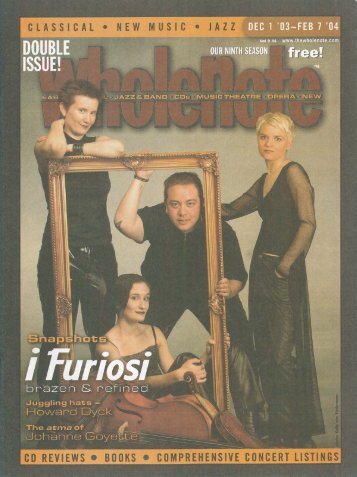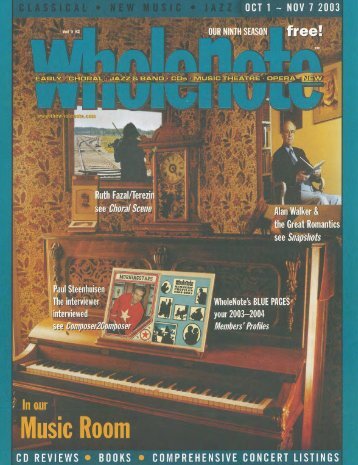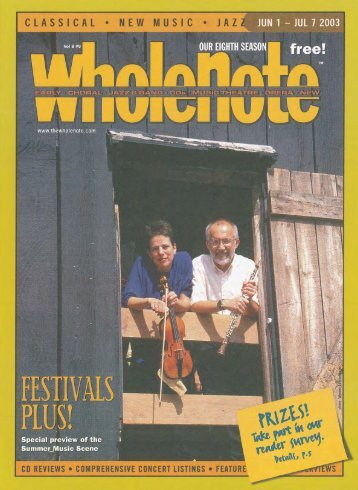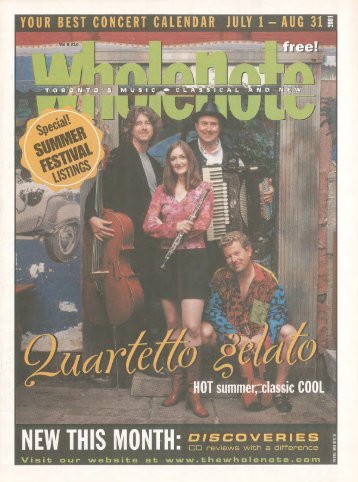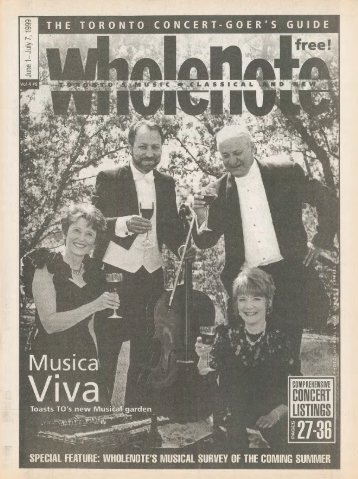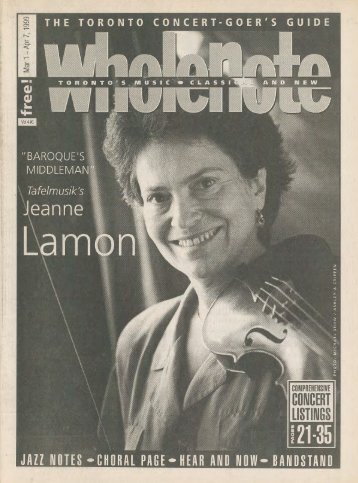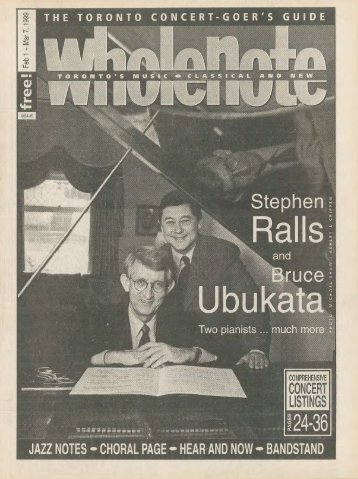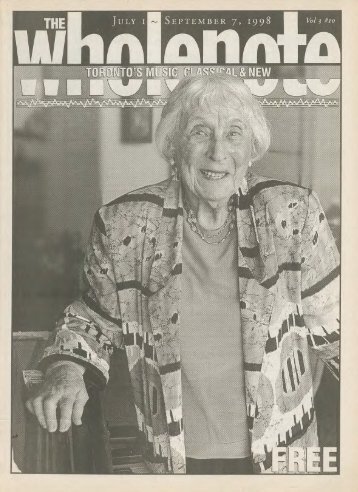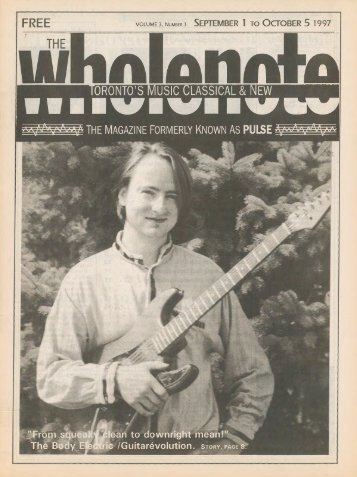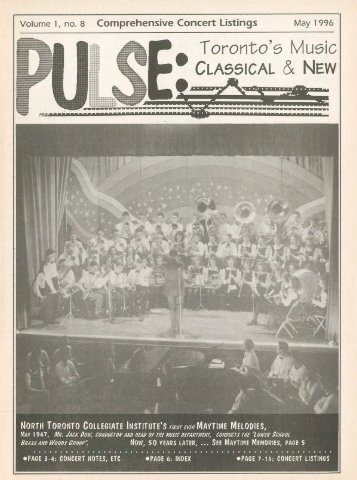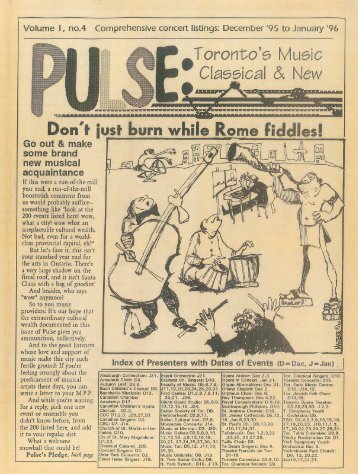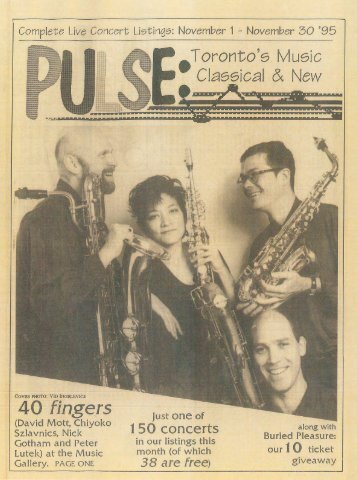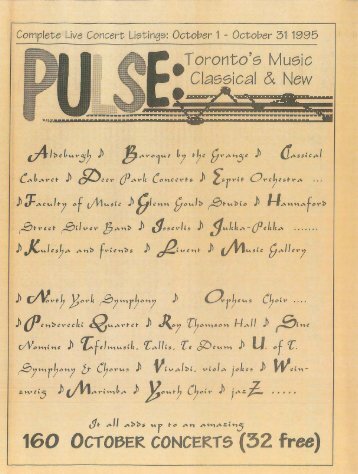Volume 13 - Issue 2 - October 2007
RECORDS
RECORDS REVIEWEDVOCALLute SongsCharles Daniels; Nigel NorthAtma ACD2 2548Charles Daniels isone of the mostprolific recordingartists around. Hehas worked withall the top earlymusic groups,especially in hisnative England.Toronto audiencesknow him from his performances with Tafelmusikand the Toronto Consort. Yet it's rare tohear him in a solo recital, either in concert oron disc. So this collection oflute songs, thesecond he has recorded for ATMA, is especiallywelcome.The composers on this disc were all contemporariesof John Dowland, the master of theRenaissance lute song. But just a few songs inthis collection - like Thomas Campion 's I carenot for these ladies and Philip Rosseter'sWhen Laura smiles - are familiar.Although lute songs present a full range ofmoods and tempos, after a while they caneasily end up sounding similar. But Danielsprovides remarkable variety with his dramaticshading. Apart from the occasional signs ofstrain in his lowest notes, he is in great voice.His expressive range is virtuosic. In the plaintiveGoe passions to the cruel/ faire by ThomasFord, even a simple rising scale becomesexciting. He is liberal with wordpainting andplaintive sighs. But, unlike some of his youngercounterparts, who seem to feel that more isbetter, he is judicious in his use of ornamentation.Throughout, lutenist Nigel North dazzleswith his lyricism and nimbleness. The finebooklet notes, including texts and performers'biographies, as well as the clear sound, helpmake this a delightful disc.Pamela MarglesEARLY MUSIC - APLETHORA OF BACHBach - Weimar CantatasEmma Kirkby; Michael Chance;Charles Daniels; Peter Harvey;The Purcell QuartetChaconne (Chandos Early Music)CHAN 0724early cantatasdelivers just that.This set includesfour cantatas, allwritten after Bachhad been promotedfrom organist toconcertmaster atthe ducal court ofWeimar, where hewas charged withthe enormous task of composing a new cantataevery month in keeping with the liturgical calendar.Bach's prolific output during this timedid not affect the expressiveness of this musicin any way. Listen to the opening chorus ofBWVl2, Weinen, Klagen, Sorgen, Zagen(weeping, sighing, sorrowing, crying) and hearhow skilfully the musicians interpret the throbbingangst inherent in the text, and how brightlythe sorrow, once fully experienced, transformsto joy. Similarly, BWV61, NunnkommderHeiden Heiland changes from the repetitiveknocking on the door in the bass recitativesung by Peter Harvey with an almost frighteningtone of insistence, to Emma Kirkby's absolutelyjubilant performance of the closing aria.In BWVl61, Komm, du susse Todesbande,the listener is startled by the clock imagerystriking the hour of death accompanying thealto part delivered in heart-rending pleas byMichael Chance, while tenor Charles Danielssings brilliantly of the believer's deep desire forthe afterlife. BWVI 8, Gleichwie der Regenund Shnee, begins with a dramatic Sinfonia inwhich the Purcell Quartet particularly shinesalong with the reinforcements that reflect theinstrumental forces Bach enjoyed at Weimar.Dianne WellsConcert note: Bach's cantata Jesu, der dumeine Seele will be presented in a church servicesetting at Trinity-St. Paul's on October 28during the Toronto Bach Festival which runs fromOctober 22 until November 3.Bach - Gamba sonatasDaniel Miiller-Schott; Angela HewittOrfeo C693071 ABoth Mi.illerSchott's cello,(Venice 1727 byMatteo Goffriller),and the Fazioligrand pianoplayed by Hewitt,may seem similarto the viola dagamba and theharpsichord respectively, but are quite differentand evolved creatures than the instruments forwhich this music was composed. Were it notfor the performers' sensitivity to the historicalstyle, lightness of bowing and touch, exquisiteshading and delicate shaping of phrases, theeffect might have been like driving a Ferrari indowntown Toronto traffic.For those who prefer the clarity of scaled- It's also important to note that these are notdown, one-voice-per-part performances of simply sonatas with accompaniment for a soloBach with a stellar cast, this second volume of instrument, but rather actual three-part dia-58 WWW, THEWHOLENOTE.COMBack to Ad Indexlogue, rich in counterpoint. The independenceof each melodic line, combined with knowledgeof period practice is, of course, central to anyinterpretation of these works, and this is clearlyevident on this recording.Those familiar with Bach's music will recognizesome Brandenburg themes to be found inthe Third Sonata. The beautiful First Sonata isalso known in a version for two flutes andcontinua.Although one might have wished for a littlemore spontaneity, a less metrically-calculatedornamentation, and more purposeful, ratherthan cosmetic, shifts in volume, there are probablymany who would prefer this moderninstrumentinterpretation over period instruments.Given the fine quality of this performance,who could blame them?Frank NakashimaConcert note: Angela Hewitt and DanielMillier-Schott perform Bach's Gamba SonataNo.3 and works by Beethoven, Schumann andFranck at the Capitol Arts Centre in Port Hopeon October 20. Angela Hewitt will play Bach'sWell-Tempered Clavier cycle by memory on aFazioli piano over two recitals at Glenn GouldStudio on October 22 and 24 as part of her WorldBach Tour.Bach - Sonatas for Violin andHarpsichordViktoria Mullova; Ottavio DantoneOnyx ONYX 4020How serendipitous it seemed, back in 1983,that the young Viktoria Mui !ova came over to"our side" from under the very nose of herKGB guardian, while on a tour. Now in her40's, her artistry seems only to strengthen astime goes on. As if a lengthy recording careerwith Philips Classics weren't enough, now sheis a headliner for Onyx records, this time withItalian harpsichordist and organist OttavioDantone. In view of her recent concert tours,this CD should generate considerable interest.Bach's six sonatas B WV I O 14-10 I 9 havebeen recorded dozens of times, but never quitelike this. Gone is Mullova's supposed sterility;here is a performer who has become moredaring with the passing years. Yet Bach reignssupreme in every phrase. The celebratedGuadagnini violin weaves its magic, along withDantone's Silbermann double manual copy thatis as sweet as baroque instruments can be.At the end of each CD you'll find bonustracks, the Trio Sonata no.5 BWV 529 in C,and G major Sonata BWV I 021 for violin andcontinua. Gambist Vittorio Ghielmi and lutenistOCTOBER 1 - NOVEMBER 7 2007
Luca Pianca make guest appearances. Eventhough the G major was recorded along withthe rest of the works in the Alte Grieser Pfarrkirchein Balzano, careful listening will indicatethat they must have used a different cornerof the sanctuary, with a different reverberationpattern.Recommended.John S. GrayConcert note: Reviewer James Parker andhis Gryphon Trio perform Beethoven, Sylvestrovand Ravel at Music Toronto on October 16.MODERNAND CONTEMPORARYCLASSICAL AND BEYONDLT. l ll1 ,11 ,1.i.\:s·~ .: r 1 t ,1 \llom 11 1 \, 111'\'I \~,".;l. 1 rn l~11,i,n ,Hoffmann - Sonatas;Schumann - KreislerianaLuisa Guembes-BuchananStrecketon Berlin DA 55305(www.cdbaby.com/cd/guembesbuchanan2)Latin-American pianist Luisa Guembes-Buchananhas released an interesting double CD thatmixes musical and literary worlds. The rarelyperformed piano sonatas ofE.T.A. Hoffmann(the surviving five of eight works in this genre)are coupled with Robert Schumann's Kreisleriana,which was inspired by the writings ofHoffmann. Schumann saw a kindred spirit inthe works of Hoffman, where worlds of fantasyand reality mixed ecstatically and eerily.Guembes-Buchanan, in addition to being afirst-rate performer and clinician, has writtenexcellent liner notes, where she concentrateson Hoffmann with an illuminating biography,and program notes for each sonata. She makesthe case for Hoffmann being somewhat underratedas a composer historically, and that hewas a significant bridge between the Classicaland Romantic eras of music. In this regard,Hoffmann is obviously eclipsed by the toweringachievements of Beethoven, but I enjoyed theHoffmann sonatas and Guembes-Buchanan 'sperformances very much.In the Hoffmann sonatas, we hear elegance,clarity of texture, and charming finger passagework.In particular, some of the slowmovements reveal a strong sense of drama, notsurprising considering Hoffmann 's fifty oddworks for the stage (most of them unfortunatelylost). We also hear Hoffmann experimentingwith form in these sonatas, with mixed results.The Schumann performance is full of Mercurialflights of fantasy, contrasting well withgentle lyricism and rhythmic passages. Guembes-Buchananbrings a lovely tone quality outof the historic piano that she performs on, andcontinually reveals a lovely sense of rubato inher playing.James ParkerBrahms - Symphony No.IPittsburgh Symphony Orchestra;Marek JanowskiPentaTone PTC 5186 307Brahms waited until he was 43 before completinghis first symphony in 1876. Like manycomposers, he was plagued with constant selfdoubtsand self-criticism, and after all , he hadthe shadow of the great mogul, Beethoven,hanging over him. But what a first effort!Brahms clearly showed the world - despite thesneers coming from supporters of Liszt andWagner - that the principles of classicism stillhad a place in l 9th-century music. This newrecording, an SACD on the PentaTone labelfeaturing the Pittsburgh Symphony conductedby Marek Janowski, is a delight. What a fulland rich sound this ensemble produces, itsinterpretation ably capturing the music's spiritof noble grandeur. From the opening chords(which to me always sound somewhat forbidding!),it's clearly discernible that this orchestrais in full command of the music. The warm andlush sound of the strings is forever complementedby the vigour of the brass throughoutall four movements - the restless opening, thelyrical and reflective andante, the graciousthird movement, and the triumphant finale.Opening this disc is the often-played Variationson a Theme by Haydn composed in1873 . Whether or not the theme actually wasby Haydn has always been open to conjecture,but nonetheless, it's a fine melody, and Brahmsputs it to good use in this set of eight variations.Once again, the Pittsburgh Symphonycomes through under Janowski's competentbaton, providing a sensitive and spirited performance.There is a wonderful transparencyof sound here, allowing all the contrapuntalactivity to be heard to full advantage. In all,two great works superbly performed by anorchestra that continues to demonstrate thereis more to Pittsburgh than steel and the Steelers!Recommended.Richard HaskellConcert note: The York Symphony Orchestraperforms Brahms' Symphony No. I and theAcademic Festival Overture on October 20 atTrinity Anglican Church in Aurora and October21 at the Markham Theatre. Toronto'sCounterpoint Community Orchestra willperform Brahms Symphony No. I on itsDecember I concert under the direction ofTerry Kowalczuk.Under the Sign of the Sun - French Worksfor Saxophone and OrchestraClaude Delangle; Singapore SymphonyOrchestra; Lan ShuiBIS BIS-CD-1357In his ninth fine release on the BIS label, saxophonistClaude Delangle (Professor at theParis Conservatory) looks back to the standardFrench concerto repertoire. Legitimized as a"classical" instrument in the early twentiethcentury, the saxophone gained a significantrepertoire from composers such as Ibert, Schmitt,and Milhaud.lbert's Concertina da camera remainsperhaps the most important work in the saxophonerepertoire. Originally for saxophone andeleven instruments, its treatment here is withaugmented strings. Delangle 's smooth techniqueand crystalline tone amaze the listener ashe acrobatically shifts registers.Corsican composer Henri Tomasi 's Concertois a tour de force for soloist and orchestra.Its cyclical form is reminiscent ofFranck, andthe orchestration is as rich as the interludesfrom Pelleas et Melisande. Listening today, Ihear this work as a score to a movie in whichthe saxophone is the protagonist.Three pieces get their original treatmentwith orchestra on this disc: Paule Maurice'sTableaux de Provence is a recueil of miniaturesevoking the pays d'Oc; Florent Schmitt'sLegende is an improvisatory arabesque; andMilhaud's dance-like triptych Scaramouche islight and fun. Regularly heard in versions withpiano, it is a pleasure to hear the orchestralaccompaniment to these three, and Lan Shuileads the Singapore Symphony Orchestra withskill and bravado.But it is the soloist who shines. Delanglecontinues to secure his place in historyamongst the greatest saxophonists - his playingcombines the clean articulation of MarcelMule and the stratospheric range of SigurdRascher. At home in the repertoire of his compatriots,Delangle's refinement of techniqueand sound solidifies the saxophone's place infront of the orchestra.Wallace HalladayConcert note: Reviewer Wallace Halladay isthe featured soloist in Ibert's ConcertinaSchmitt's Legende and other works with 'theKitchener-Waterloo Symphony on October 18O CTOB ER 1 - N OVE MBER 7 2007Back to Ad IndexWWW. THEWHOLENOTE.COM59
- Page 1 and 2:
AftIIIVIIIIPILAYlNG LIKE THEPED.SOt
- Page 3 and 4:
G,'ICI IJ\.NGEU•. HEWIHBack to Ad
- Page 5 and 6:
wholenoteVolume 13, #2, October 1 -
- Page 7 and 8: often as not lingered to listen to
- Page 9 and 10: BYZANTINE 2007FESTIVALByzantine I:M
- Page 11 and 12: Sunday October 21, 2007William Bolc
- Page 13 and 14: the Fazioli. But some people just h
- Page 15 and 16: m~infqnia1oronLoNURHAN ARMANMUSIC D
- Page 17 and 18: EARLY Musicby Frank NakashimaB is f
- Page 19: (the period immediatelypreceding Ma
- Page 22 and 23: SoME THING NewBY JASON VAN EYKOf By
- Page 24 and 25: 24Back to Ad IndexTwENTy•REuNI0Np
- Page 26 and 27: .%onto Operetta Theatre presents ac
- Page 28 and 29: WE ARE All Music's CHILDRENby mJ Bu
- Page 30 and 31: ... CONCERTS: Toronto and GTAThursd
- Page 32 and 33: ... CONCERTS: Toronto and GTAMozart
- Page 34 and 35: ... CONCERTS: Toronto and GTA- 8:00
- Page 36 and 37: ... CONCERTS: Toronto and GTA(ad
- Page 38 and 39: ... CONCERTS: Toronto and GTA- 8:00
- Page 40 and 41: Glenn Gould Studio . CBC Building.2
- Page 42 and 43: ... CONCERTS: Toronto and GTADister
- Page 44 and 45: CONCERT LISTINGSBeyond the GT AIn t
- Page 46 and 47: Oshawa. 905-576-0417. .50(advanc
- Page 48 and 49: Opera, MusicTheatre, DanceCONTINUED
- Page 50 and 51: THEROYALCONSERVATORY OFMUSICDon't j
- Page 52 and 53: A CHORAL LIFE Q &ACONTINUED FROM PR
- Page 54 and 55: WholeNote MarketPlaceEducation1PNOR
- Page 56 and 57: Book Shelfby Pamela MarglesWish I C
- Page 60 and 61: and 19. On October 20 the Muskoka S
- Page 62 and 63: ACKbEAT: ••• READERS REPLYLet
- Page 64 and 65: •Bacchus et Ariane, SuiteBack to
- Page 66 and 67: C HRJST C HURCH DEER PARKC HRISTMAS
- Page 68 and 69: CANADIAN CHILDREN'S OPERA CHORUSNow
- Page 70 and 71: CIVIC LIGHT OPERA COMPANYFounded in
- Page 72 and 73: EPO is also keeping the young at ar
- Page 74 and 75: The church has just finished amajor
- Page 76 and 77: the Canada Council, CAPACOA, and va
- Page 78 and 79: NORTH 44° ENSEMBLENorth 44° Ensem
- Page 80 and 81: Hymnathon fundraiser. All concerts
- Page 82 and 83: generating opportunities for dynami
- Page 84 and 85: North 44° (see separate listing) i
- Page 86 and 87: include countless awards, featured
- Page 88: VISUAL AND PERFORMING ARTSNEWMARKET
Inappropriate
Loading...
Mail this publication
Loading...
Embed
Loading...
























